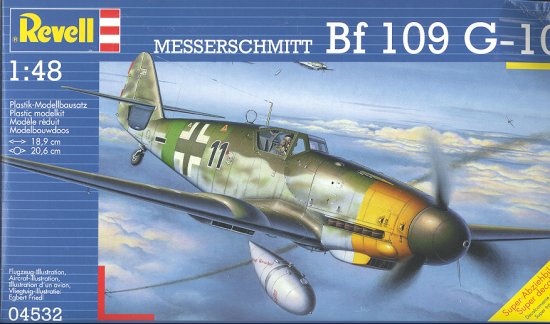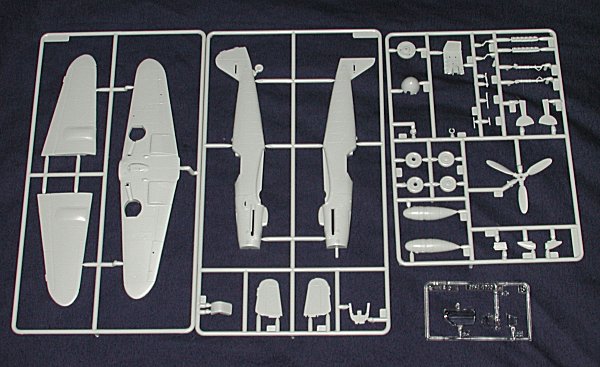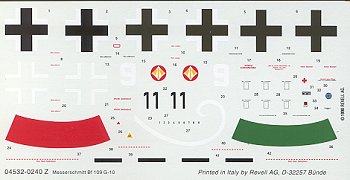
Revell 1/48 Bf-109G-10
|
KIT: |
Revell 1/48 Bf-109G-10 |
|
KIT # |
4532 |
|
PRICE: |
$ |
|
DECALS: |
Two aircraft |
|
REVIEWER: |
|
|
NOTES: |
|

|
HISTORY |
The G-10 was the fastest of the 109 series. While it was originally thought that these were recycled airframes, that is not the case. These were airframes on the production line that were basically brought up to 109K specs with the inclusion of the uprated engine and other airframe parts. It was used from late 1944 until the end of the war.
|
THE KIT |
Revell's kit of the 109G-10 is an old friend to many of us. Probably the first
'modern' 109 kit in the area of fidelity and engraved panel lines, it has been
built by the tens of thousands over the years. Your esteemed (in his own mind)
editor has done at least two of them as G-10s (here is review
1 and 2) and one as K,
following instructions in an old IPMS/USA magazine.
Anyway, this is the same, unchanged kit from way back about 30 years ago. The
first thing you will notice is that there is a touch more flash than one would
have seen in the older kits. It is most noticeable in the interior and in the
tailplanes. The trim tabs are no longer separated, but fused together by flash.
There are ejector stubs and holes on the landing gear just like the older
molding. The canopy is still a single piece with rather poorly delineated
frames. Sidewall detail is still rather shallow, however, there are no sink
marks on any parts, which is a blessing in and of itself.

 What has changed are the
instructions and the decals. The instructions are now more than just a large
sheet of paper, but are now in line with the rest of Revell AG's instructions.
They are typical 'Euro-instructions' with no construction write-up. They also
have only Revell paints listed and you'll have to mix some colors when using
them. However, we Luftwaffe pros know the proper colors so it isn't a barrier to
us. Also new, and prominently featured on the box top are the decals. The kit
provides two options. One is the box art plane from II./JG 27 is March of 1945.
It is in late war RLM colors of 81/82 over 76, with a yellow nose and a nice
green Reich Defense band. The other is an overall RLM 76 aircraft of III./JG 1
in November of 1944 with a nice red band. All the required markings are
provided on a nicely printed, but matte decal sheet. This includes the tail
bands. Were I to use the kit sheet, I'd test the band I wasn't going to use on
the kit before starting to paint it to make sure it would work well. Naturally,
no swastika is provided, but finding one shouldn't be a problem.
What has changed are the
instructions and the decals. The instructions are now more than just a large
sheet of paper, but are now in line with the rest of Revell AG's instructions.
They are typical 'Euro-instructions' with no construction write-up. They also
have only Revell paints listed and you'll have to mix some colors when using
them. However, we Luftwaffe pros know the proper colors so it isn't a barrier to
us. Also new, and prominently featured on the box top are the decals. The kit
provides two options. One is the box art plane from II./JG 27 is March of 1945.
It is in late war RLM colors of 81/82 over 76, with a yellow nose and a nice
green Reich Defense band. The other is an overall RLM 76 aircraft of III./JG 1
in November of 1944 with a nice red band. All the required markings are
provided on a nicely printed, but matte decal sheet. This includes the tail
bands. Were I to use the kit sheet, I'd test the band I wasn't going to use on
the kit before starting to paint it to make sure it would work well. Naturally,
no swastika is provided, but finding one shouldn't be a problem.
|
CONCLUSIONS |
In case you can't tell, I really like kits like this. They have many redeeming qualities. First of all, they are inexpensive compared to the Japanese wonder kits. Secondly, they don't have a ton of parts to them so can be built by those who may be intimidated by other 109 kits. Finally, they are generally accurate and provide a basis for those who wish to spruce them up with various aftermarket parts. They are also great for trying out different techniques. If you botch it really bad, then you are not out a whole lot of money.
Review kit courtesy of my kit collection.
If you would like your product reviewed fairly and quickly, please contact me or see other details in the Note to Contributors.